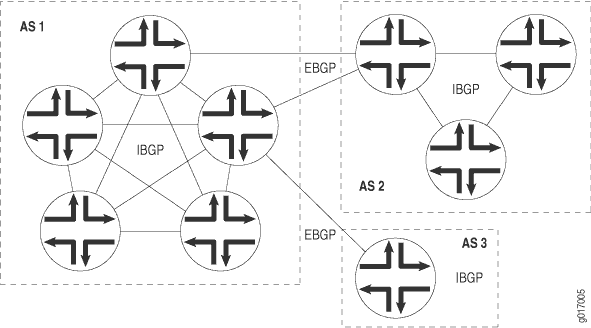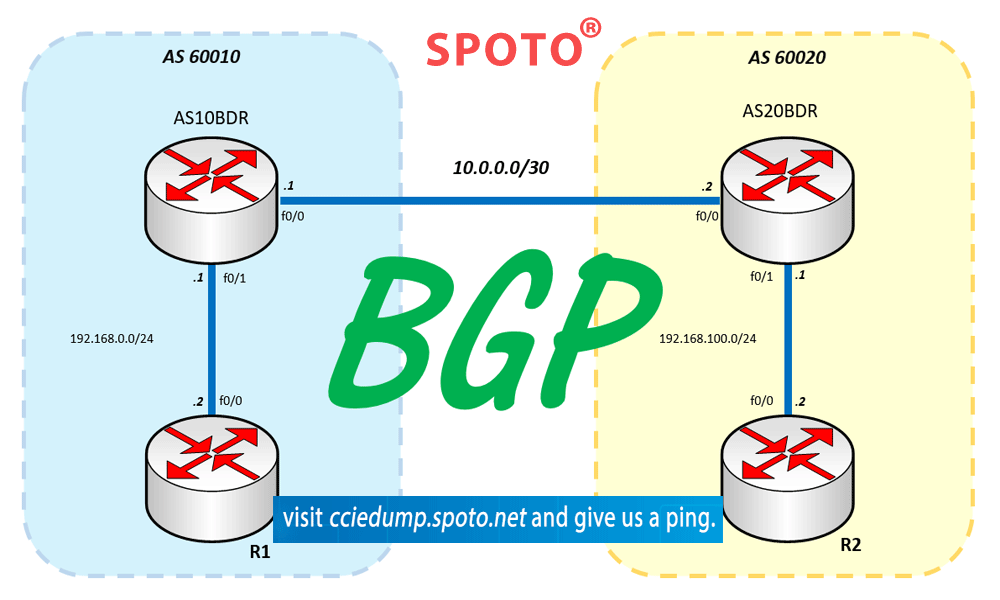BGP is an external gateway protocol (EGP), used to exchange routing information between routers in different autonomous systems (AS). BGP routing information includes a complete route to each destination. BGP uses routing information to maintain databases of network accessibility information exchanged with other BGP systems. BGP uses network reachability information to construct AS connection diagram, which enables BGP to delete routing loops and perform policy decisions at the AS level.
Now, Cisco certification exams involve BGP knowledge, and if you are want to know more details or knowledge of BGP, you can follow SPOTO.
The multi-protocol BGP (MBGP) extension enables BGP to support IP version 6 (IPv6). MBGP defines the properties of MP_REACH_NLRI and MP_UNREACH_NLRI to carry IPv4 reachability information. The network layer reachability information (NLRI) update message carries the IPv6 address prefix of feasible routing.
BGP allows policy-based routing. You can use routing policies to select multiple paths and control the redistribution of routing information.
BGP uses TCP as its transport protocol and uses port 179 to establish a connection. Running on a reliable transport protocol, there is no need for BGP to update segmentation, retransmit, confirm and sort.
Junos OS routing protocol software to support BGP version 4, which adds support for classless inter-domain routing (CIDR) and eliminates the concept of network classes. Cider allows you to explicitly specify bits in a network address, thereby reducing the size of the routing table. Instead of looking at which bits of the address are assumed to represent the network by looking at the first octal. BGP version 4 also supports routing aggregation, including AS path aggregation. This section discusses the following topics:
Note: If you’re study and preparing Cisco exams, want to know to get more study materials. Follow SPOTO. And SPOTO will offer 100% real and valid Cisco exam questions and answers to help pass the exam in the first try.
Autonomous Systems
Autonomous system (AS) is a group of routers managed by a single technology, which usually uses a single internal gateway protocol and a set of common indicators to propagate the routing information in the router settings. For other AS, AS, it seems to have a single, coherent internal routing plan and presents a consistent image of which destinations it can reach.
AS Paths and Attributes
The routing information exchanged by the BGP system includes a complete route to each destination and other information about the route. The route to each destination is called an AS path, and other routing information is included in the path attribute. BGP uses the AS path and path attributes to fully determine the network topology. Once BGP is aware of the topology, it can detect and eliminate the routing loops and select in each group of routes to implement management preferences and routing policy decisions.
External and Internal BGP
BGP supports two types of routing information exchange: switching between different AS and switching within a single AS. When used between AS, BGP is called an external BGP (EBGP), and the BGP session performs an inter-AS route. When used within the AS, BGP is called an internal BGP (IBGP), and the BGP session performs intra-AS routing. FIG.1 illustrates AS, IBGP, and EBGP.
Figure 1: ASs, EBGP, and IBGP

BGP systems share network accessibility information with adjacent BGP systems. These BGP systems are called neighbors or peers.
The BGP system is arranged by the group. In the IBGP group, all peers in the group, called internal peers, are both in the same AS. The internal peers may be located anywhere in the local as and do not have to be directly connected to one another. The internal group uses a route from igp to resolve the forwarding address. They also propagate an external route between all other internal routers running the ibgp, calculate the next hop by acquiring the BGP next-hop received with the route, and parse it using information from one of the internal gateway protocols.
In the EBGP group, the peers in the group (called external peers) are located in different AS and usually share subnets. In an external group, the next hop is calculated relative to the interface shared between the external peer and the local router.
You can watch SPOTO free training course on Basic Knowledge of BGP Technology-SPOTO CLUB
Multiple Instances of BGP
You can configure multiple instances of BGP at the following hierarchy levels:
[edit routing-instances routing-instance-name protocols]
[edit logical-systems logical-system-name routing-instances routing-instance-name protocols]
Multiple instances of BGP are primarily used for Layer 3 VPN support.
Both IGP peers and external BGP (EBGP) peers (non-multi-hop and multi-hop) support routing instances. BGP peers are established on one of the interfaces configured under the routing instance hierarchy.
Note: If you’re study and preparing Cisco exams, want to know to get more study materials. Follow SPOTO. And SPOTO will offer 100% real and valid Cisco exam questions and answers to help pass the exam in the first try.
It is shown that when BGP neighbors send BGP messages to local routing devices, the incoming interface to receive these messages must be configured in the same routing instance where the BGP neighbor configuration is located.
For single-hop neighbors or multiple jumps. By default, routes learned from BGP peers are added to the instance-name.inet.0 table.
You can configure import and export policies to control the flow of information in and out of the instance routing table. For layer 3 VPN support, configure BGP on the provider edge (PE) router to receive routes from the customer edge (CE) router and, if necessary, send the routing of the instance to the CE router. You can use multiple BGP instances to maintain separate forwarding tables per site to keep VPN traffic separated on PE routers.
You can configure import and export policies to allow service providers to control and limit traffic with customers. You can configure EBGP multi-hop sessions for VRF routing instances. In addition, you can use the loopback address of the CE router instead of the interface address to establish the EBGP peer between the PE and CE routers.

 Join Telegram Study Group ▷
Join Telegram Study Group ▷














